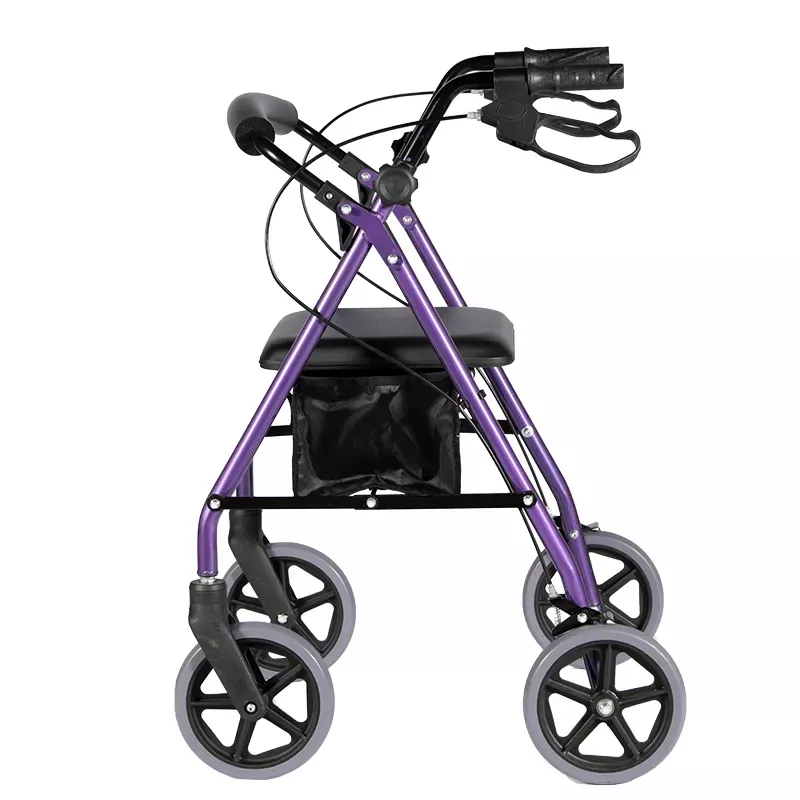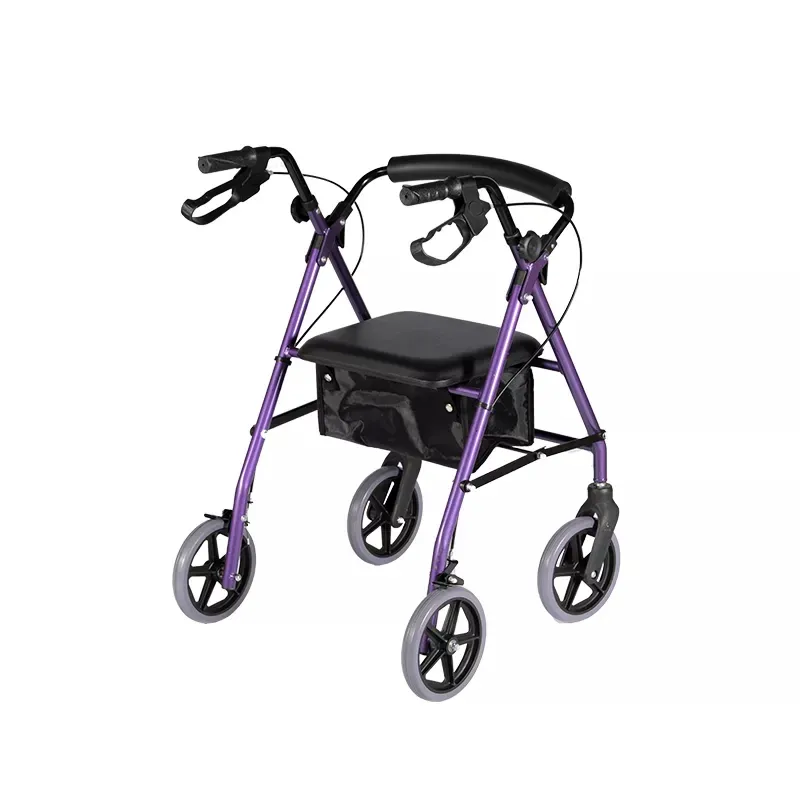From traditional crutches and wheelless walking frames to 4-wheeled rollators and manual wheelchairs, the options for assistive mobility devices are growing. In daily life, it's still common to see 4-wheeled rollators used as "makeshift wheelchairs," with the seat used as a carrying chair to transport people or patients short distances.
Rehabilitation physicians, physical therapists, and patients' families are asking: Why can't 4-wheeled rollators be used as wheelchairs? What are the irreplaceable advantages of manual wheelchairs?
This article, combining authoritative guidelines and research evidence, will analyze the design differences, usage scenarios, potential risks, and clinical decision-making tips between the two, providing practical guidance for patients, caregivers, and primary care providers.

What is a 4-wheeled rollator?
A 4-wheeled rollator is a push-type walker with four small wheels, an adjustable handle, often equipped with a handbrake, a foldable seat, and a storage basket. It is designed to help users maintain balance while walking, reduce energy consumption, and allow for short periods of sitting and rest. Its core function is to assist walking, not to replace sitting.
What is a manual wheelchair?
A manual wheelchair is an assistive device used for long-term sitting and mobility. Its design takes into account weight bearing, stability, foot/leg support, wheel brakes, and mobility control (self-propelled or pushed). Manual wheelchairs are categorized by purpose, including self-propelled (user pushes the rear wheels) and transport chairs (propelled by a companion). Their structure and safety features (footrests, footrests, wheel locks, armrests, seat cushions, and back pads) are designed for safe sitting and mobility. The WHO and national rehabilitation systems consider wheelchairs to be medical and rehabilitation devices, requiring measurement, fitting, and training.
4-wheeled rollator vs. manual wheelchair: Why are they not equivalent?
Mistaking "similar appearance" for "similar function" is a source of risk. The following lists the key structural differences between 4-wheeled rollator and manual wheelchairs and explains why these differences lead to distinct functional and safety features.
1. Load and Sitting Posture Design
• The seats of 4-wheeled rollator chairs are typically designed for temporary sitting. Their design lifespan and load distribution are not ergonomically optimized for continuous sitting. The seat cushion area, depth, and lateral support are insufficient, and prolonged sitting or use as the primary weight-bearing position can increase the risk of instability and pressure sores.
• Manual wheelchairs are designed for long-term sitting. They offer a variety of seat widths, depths, heights, backrests, and cushion materials, and can be configured with pressure-distributing cushions and lateral supports. These are suitable for extended sitting and reduce the risk of pressure sores and postural deformities. (World Health Organization, World Health Organization Application)
2. Braking and Fixing Mechanisms
• The handbrakes of 4-wheeled rollator chairs are primarily used for braking during movement or for short-term immobilization. Many models are not designed to withstand the full force of a sitting person (some models require foot or hand braking). If the user sits and leans forward or moves suddenly, the brakes may not reliably "grip" the ground like the wheel locks, resulting in the risk of the chair slipping or structural displacement.
• Wheelchairs are equipped with durable wheel locks and more secure locking positions, and are designed for safety during repositioning, transport, and transportation. The Mayo Clinic's rehabilitation manual also distinguishes between the key differences in wheel lock operability between standard wheelchairs and transport chairs.
3. Foot and lower limb support
• 4-wheeled rollator seats often lack reliable footrests or adjustable footrests. When sitting on them, the user's lower limbs may be suspended in the air or placed on the ground, where they may become trapped by the wheels, increasing the risk of foot entrapment or dragging.
• Manual wheelchairs are equipped with specialized footrests or legrests that can be adjusted in height and angle to protect the ankles and prevent pinching. (World Health Organization)
4. Stability and tipping characteristics
• The center of gravity, wheelbase, and steering of a 4-wheeled rollator are designed to maintain stability when the user is standing and pushing. When the user sits in the seat and shifts their weight rearward (for example, by leaning back or turning around), the center of gravity distribution may change, causing the vehicle to tip backward or become unstable.
• Wheelchairs are designed with considerations for seated center of gravity and tip-over protection (leg tilt, seat depth, etc.), and can be adjusted specifically to the user's body shape.
Based on the above points, a 4-wheeled rollator should not be used for carrying, transporting, or as a replacement for a wheelchair—especially if the person is unable to stand on their own or needs to be carried. In fact, clinical documentation explicitly states, "Patients should not be transported in a rollator seat."

What are the potential harms of using a 4-wheeled rollator as a wheelchair?
Possible harms of using a 4-wheeled rollator as a wheelchair:
1. Falls due to slipping/rolling
2. Risk of tipping over and head/femur fractures
3. Crushing/pinching of the lower limbs and toes
4. Skin pressure and pressure ulcers
1. Falls due to slipping/rolling
If the brakes are not secure or the surface is uneven, causing the rollator to slide, the user could fall from the seat. Research and user reports indicate that wheeled rollators pose a risk of loss of control on slopes or slippery surfaces.
2. Risk of Falls and Head/Femur Fractures
In falls, elderly individuals are at high risk of serious injuries due to head or hip injuries. Improper use of rollators can increase the incidence of these accidents. Although some studies have shown that proper use of rollators can reduce the risk of fractures in walking falls, accidents involving devices used for sitting and transportation are not uncommon.
3. Crushing/Pinching of Lower Limbs and Toes
Sitting without footrests or footrests makes it difficult to stabilize the user's feet, making them vulnerable to being caught or trapped by the wheels, especially during turning or being pushed.
4. Skin Compression and Pressure Ulcers
Ad hoc cushions cannot adequately distribute pressure during prolonged sitting. Prolonged sitting in non-wheelchair-mounted seats increases the risk of skin necrosis and pressure ulcers, especially for patients with sensory impairments or those who cannot change position independently.
In summary, based on the types of accidents and research evidence, using a four-wheeled rollator as a wheelchair increases the risk of preventable injuries. Professional rehabilitation programs and patient education emphasize avoiding such substitutions.

What are the advantages of manual wheelchairs?
Why are they needed in many situations?
When the goal is to safely move a person while seated, manual wheelchairs offer several irreplaceable advantages, each of which is explained below and supported by authoritative sources.
1. Load-bearing and pressure management designed for sitting
The seat cushion, backrest, seat depth, and width of a manual wheelchair can all be selected or adjusted to the user's physique and sitting posture. Pressure-distributing cushions can also be used to reduce the risk of bedsores. WHO wheelchair service training emphasizes that the correct chair type and seat cushion are crucial to the health and quality of life of long-term users.
2. Reliable braking and securing (including safety during transfers)
Manual wheelchairs are equipped with wheel locks that can withstand transfer torque, and transport and self-propelled wheelchairs are designed for different usage scenarios (self-propelled wheelchairs are propelled by the user themselves, while transport models are propelled by a companion and have different wheel locking mechanisms). Mayo Clinic's information on mobility devices details the differences in wheel locks and stability between wheelchairs and transport chairs.
3. Lower Limb Support and Anti-Pinch Design
The wheelchair's footrests/footrests support the legs and ankles, preventing the feet from dragging on the ground or being pinched by the wheels, while also reducing the risk of sprains and injuries during transport.
4. Posture and Functional Assistance (Customizable)
For those who require additional postural support (such as those with central nervous system impairment or dystonia), manual wheelchairs can be equipped with side supports, lap belts, and tilt/seat height adjustments to help maintain sitting posture, prevent lateral tilt, and promote safe breathing and swallowing. This is also emphasized in WHO wheelchair service training.
5. Long-Term Benefits of Professional Fitting and Skill Training
Research has shown that through systematic wheelchair fitting and user training (including the WHO's 8-step service process and school and community-based training programs), manual wheelchair users experience significant improvements in mobility independence, health-related quality of life, and safety. In contrast, alternative uses without fitting and training (such as using a rollator as a wheelchair) lack these long-term safety guarantees.
When should a 4-wheeled rollator be used?
When is a manual wheelchair essential?
A 4-wheeled rollator and a manual wheelchair are not interchangeable in terms of function. The former is a walking aid for "walking/short-term parking," while the latter is a medical rehabilitation device for "sitting and long-term sitting support." However, using a 4-wheeled rollator as a wheelchair not only violates the device's original design intent but also significantly increases the risk of slipping, tipping, foot entrapment, and pressure sores. Therefore, it's crucial to prioritize specific use scenarios!
1. Suitable Use Scenarios for a 4-wheeled Rollator
• Users who can stand on their own and apply force using the handbrake, primarily seeking improved walking efficiency, extended outdoor activities, and frequent rest breaks;
• Users with mild to moderate balance issues but sufficient upper limb strength to park the rollator before returning to a seat when necessary;
• Those whose home environment is mostly flat, who travel short distances, need to carry shopping items, and have good cognitive function.
2. Situations where a manual wheelchair is necessary
• The user is unable to stand safely or requires transport;
• The user needs to sit for extended periods (e.g., traveling to and from the clinic, multiple trips, or physical fatigue preventing them from standing) or has impaired skin sensation or is at high risk for pressure ulcers;
• The user has lower limb weakness, requires ankle or leg support, or has cognitive impairment that prevents them from properly using the brakes and sitting position;
• The doctor/therapist has explicitly stated that weight bearing is not permitted, or there are postoperative weight-bearing restrictions, requiring specialized transport.

Dayang Medical's three recommendations for patients
1. If the user can stand and use a walker for mobility, frequently needs to walk short distances outdoors, and requires frequent rest breaks, a 4-wheeled rollator is an option;
2. If the user needs to be transported, cannot stand for extended periods, or requires prolonged sitting, a manual wheelchair or transport chair should be selected and trained through formal channels;
3. Regardless of the choice, the user should receive assessment and practical training from a rehabilitation professional to avoid irreversible health damage caused by an alternative mindset ("anything goes").
What certifications does Dayang Medical hold?
Dayang Medical has passed ISO13485, ISO9001, FDA, and TUV certifications, and all our medical equipment has CE certification. This ensures that our products, such as electric wheelchairs, hospital beds, and walking aids, meet global safety and quality standards. Buyers looking for a reliable China manufacturer and wholesale supplier benefit from our high-quality guarantee.
If you are purchasing medical equipment from China, Dayang Medical offers affordable options, factory-direct supply, and international compliance.










